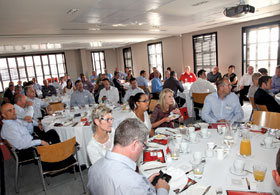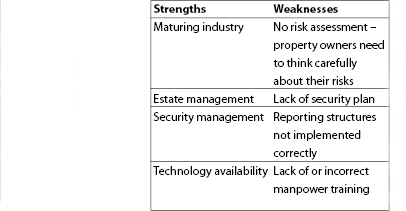

Hi-Tech Security Solutions held its first invitation-only Executive Breakfast focusing on residential estate security on the 6th November in Johannesburg. Held at the Forum in Bryanston, the event was packed with people responsible for the security of estates who came to hear Dr Craig Donald, Rob Anderson and Vagn Nielsen speak.

In addition to the speakers, six sponsors filled the exhibition space. Guests were able to examine the sponsors’ products and engage in discussions about their solutions and services during the coffee break and during the networking session after the presentations. The sponsors of this event were: Axis Communications, Cathexis, Comb Communications, Elvey Security Technologies, Powelltronics and RDC.
Feedback from the event was, without exception, positive, with guests complimenting the speakers and the information delivered. Below is a brief review of the event. Due to the numerous requests to run the event in different cities next year, Hi-Tech Security Solutions will run an estate security breakfast in both Cape Town and Durban early in 2014. Watch this space for further details.
Human factors and relationships in enabling estate security services

Dr Craig Donald, director at Leaderware, believes that an effective security plan for estates is dependent on people and relationships. “Sadly, the security officer is often the one who takes the heat when there are issues with security. Estate owners are often very demanding in terms of security and the technical are really only interested in whether the technology works.
“In addition, the security officer is often ill equipped to deal with stressful situations and pressure. We need to look at the role these factors play in ensuring that the security estate achieves its potential,” he added.
The keys to unlocking the potential of the security officer in a secure estate are:
* Choosing the right person with a suitable skill base.
* Creating a functional control room environment.
* Active supervision against a clear risk profile.
* Reporting lines – who has authority? This creates accountability.
* Procedures in place – what is done and when?
* Reporting and information management.
* Active supervision and involvement. Management needs to become involved with the staff and put checks in place, while at the same time being at the coalface.
“In terms of the right person for the job, the characteristics that are sought-after in this job profile include communication skills, service delivery orientation, observation skills, good memory and the ability to remain calm under pressure,” said Donald.
Skills training to equip the security officer should include conflict resolution, listening skills, problem solving, facilitation skills and information retrieval. In addition, security officers need to have specific surveillance skills that include knowing what they are looking for, optimised observation, visual analysis, situational awareness and pattern analysis.
In terms of optimised control room design, the objectives for technicians and engineers include:
* Line of sight.
* Display size and volume.
* Lighting.
* Ventilation.
* Usable space.
* Height of lighting attachments.
* Multi-tasking facilitation.
* Noise interference.
Some of the viewing strategies to consider for display management include:
* Not having too many cameras at one time.
* Understanding that cameras vary in importance across time.
* Event driven cameras can supplement regular cameras.
Donald pointed out that active supervision plays a large role in successful implementation of a security system. “One needs to direct the operator’s attention to issues. In addition, one needs to utilise the operator as a valuable source of information as well as use informal information gathering sources. In order to achieve maximised potential, human factors need to be designed in as an integrated strategic intervention.”
Making technology work in the modern security estate

Rob Anderson of Rob Anderson & Associates ,consulting security and electrical engineers, is more than qualified to comment on the ins and outs of security technology in this environment. His company has been involved in the specification, supply and monitoring of two office estates, three industrial estates, 32 secure closed estates and one secure open estate.
“People cause crime on people, so people will be part of the solution,” Anderson asserted.
Anderson explained that the concept of residential estates began back in 1985 when Denis Barker launched the Selborne Hotel, Spa and Golf Estate on the KZN South Coast. This was followed by research conducted by the Tongaat Hullett Group in 1987 that sought to uncover what elements of a residential estate would result in an increase in property values.
“They discovered that estates that were situated close to the intersection of two major routes would provide the highest return on investment, due to the obvious convenience factor,” said Anderson. “Here’s the rub though, Donald Appleyard in the US undertook research into where crime was most likely to take place and the answer was ‘near main roads, where traffic levels are higher’. This can therefore be extrapolated to mean at residential estates that are situated near major routes have the potential for higher levels of crime. The earlier estates did not see the need for high levels of security as the crime wave had not yet arrived. Enter the opportunity to implement secure estates.”
Some of the earlier residential estates include Tongaat Hullett Group’s Mount Edgecombe Estate on the KZN North Coast and Dainfern Estate in Gauteng. “In the early days, integration of security systems was unknown and there were many purpose-made solutions with no standards. Another limiting factor was the design of the gatehouse. Developed in an architect’s offices to aesthetically blend with the general appearance of the estate, no thought was given to practicalities such as traffic stacking space and a secure front door to the estate, resulting in frustration for drivers and security officers alike,” Anderson pointed out.
“In some instances, the bulk of the security spend was allocated to the design and equipping of a large control room and others had security squashed into the gatehouse. Again, the practicalities of the design were often not factored in. Other elements such as perimeter fencing or walling, are often driven by aesthetics and budget. The best type of perimeter barrier is a physically impermeable but visibly permeable fence.”
What is driving change?
A number of factors come into play with regard to the increasing move towards adopting technology to secure estates. These include:
* Increased crime levels.
* Technology becoming more cost effective.
* Increase costs of employing security guards and the associated labour issues. Often the guards are on a low salary scale, leading to disgruntlement.
* The property owner and estate management education regarding security and their demands.
* Word of mouth and referrals.
* Mature salesmen.
In terms of buyer expectations versus developer offerings, there is the problem of capital cost to the developer versus the operational cost for the owner. By putting a collaborative liaison into place between the two parties, agreement can be reached. “At all times, the property owner needs to take cognisance of the fact that living in a ‘secure’ estate does not make them impervious to crime. Complacency with regard to personal safety measures, like locking house and car doors and putting valuable items in secure areas, should be eliminated,” said Anderson.
Strengths and weaknesses around security systems

Open estates
Anderson highlighted the current Tongaat Hullett Group open estate development which is focused on high levels of CPTED (crime prevention through environmental design). He said that a good example of where natural surveillance has resulted in lowered crime levels is the housing in the UK that fronts straight onto a road. “The residents are able to view pedestrian and vehicular traffic and they alert neighbours when anything suspicious is noted. This can be a very important factor in preventing potential crime.
“In essence then, after developing a proper security plan, the residents become part of the overall solution and relationships with the local policing forums as well as the SAPS are encouraged and developed,” he added.
Conclusion
“A comprehensive and total security solution for estates should include perimeter monitoring, access control, CCTV surveillance and guarding. This is complemented by reporting and management as well as integration for an holistic result,” said Anderson. Finally, one cannot overlook the role that data security plays in the mix and this will no doubt be our biggest challenge going forward, specifically in terms of compliance with the new Protection of Personal Information (PoPI) Bill.”
Case in point: Helderberg Village

Vagn Nielsen, CEO for the upmarket Helderberg Village in the Western Cape, pointed out that with close to 800 houses on the estate and 1200 residents, together with contractors, staff and visitors, access control is definitely a high priority.
“We are currently undertaking a R15-million security upgrade which is necessitated because of the increase in crime in the Western Cape in recent years. The security upgrade will address perimeter security, access control and general surveillance and response. Electric fencing, roving guard patrols on the perimeter and the scanning of driver licences and vehicle licence plates are currently the major focal areas,” said Nielsen.
Estate management is also introducing resident awareness campaigns to ensure that residents play a more active role in the security process. “We have formed close relationships with both local community policing forums and the neighbourhood watch as well as with the SAPS. We are also installing intruder detection alarms in each residence and we have added a combination of 54 HD and thermal cameras on the perimeter. These are connected via a fibre optic network to the control room and we have a medical and armed response team in place,” he said.
“We have employed a fulltime security manager to oversee all these functions and we have decided to keep the guarding function separate from the monitoring and armed response function to ensure complete autonomy and the elimination of collusion,” Nielsen concluded.
| Tel: | +27 11 543 5800 |
| Email: | [email protected] |
| www: | www.technews.co.za |
| Articles: | More information and articles about Technews Publishing |

© Technews Publishing (Pty) Ltd. | All Rights Reserved.